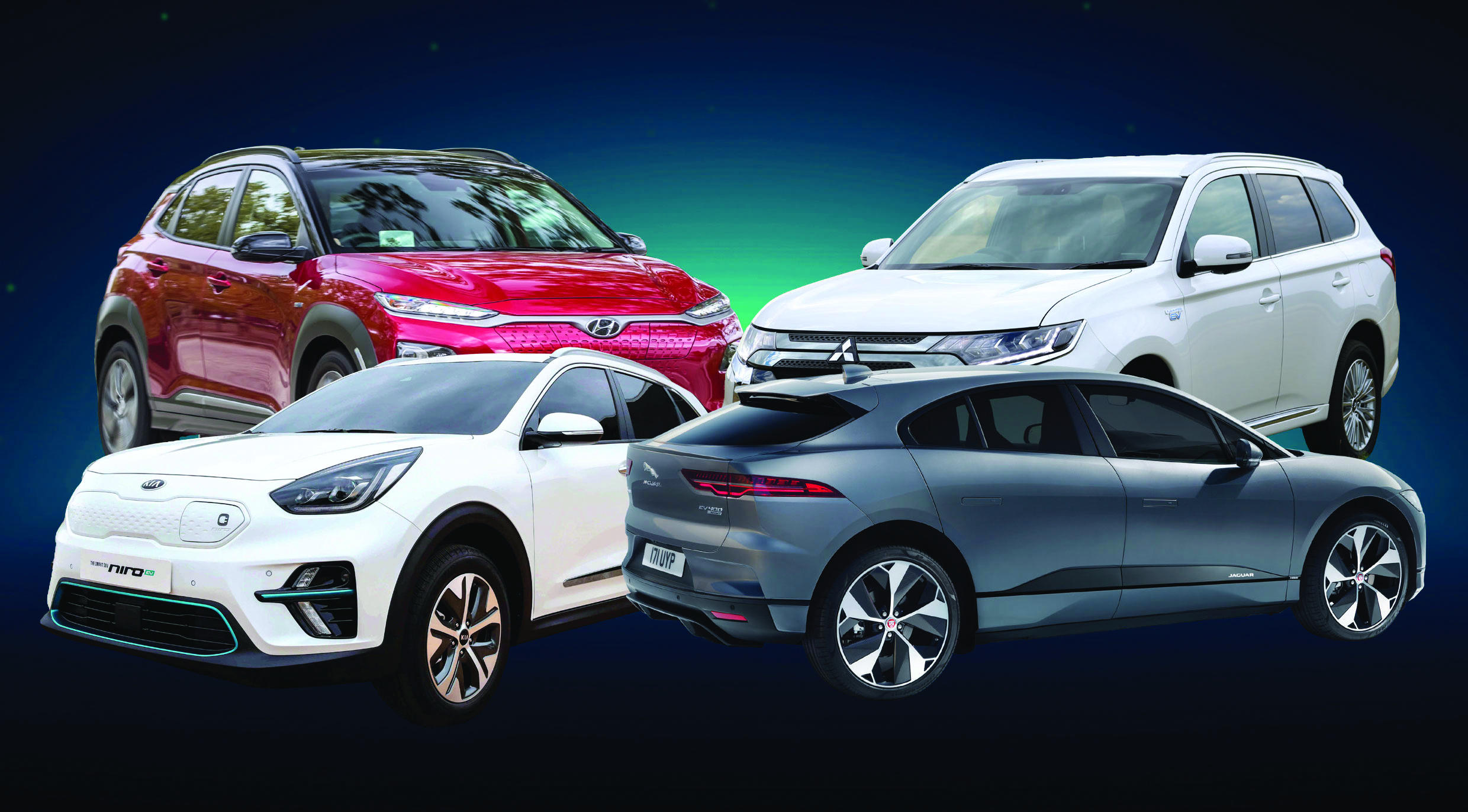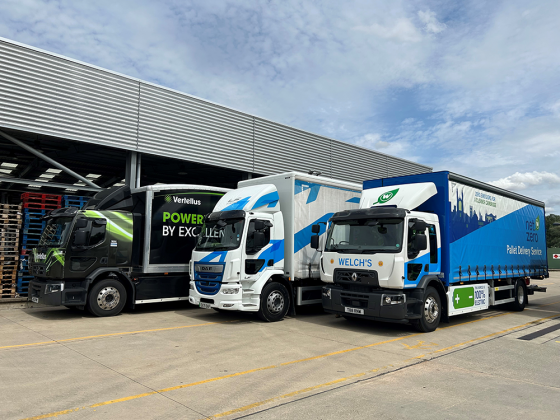Ten of the cleanest SUVs

With nearly a third of all cars on UK roads now an SUV, this motor sector has been the fastest growing for several years. With a huge range of styles and powertrains now available, we single out ten of the greenest and cleanest SUVs on the market
Hyundai KONA Electric
Hyundai is working towards developing 18 new electrified models by 2025, and the KONA Electric is its latest offering, joining both the IONIQ family and the forthcoming NEXO.
The KONA Electric brings with it the very latest in battery electric powertrain and connected technology, with a driving range of up to 300 miles.
It is available in 39kWh/135PS or 64kWh/204PS battery and motor combinations.
Front styling changes include a signature silver garnish connecting the high level daytime running lamps, a closed grille incorporating the charge point and a redesigned front bumper with active air flaps.
From the side, the vehicle’s dedicated alloy wheels, lower side skirt and wheel arch side claddings differentiate it from the internal combustion engine versions of KONA.
Prices start from £29,495 (excluding Plug In Car Grant) for the KONA Electric SE 39kWh.
KONA Electric is available to order from Hyundai’s Click to Buy website, with rollout across the dealer network in 2019.
Kia Niro

The hybrid Kia Niro joins the South Korean automaker’s green-car line-up, comprising the all-electric Soul EV and Optima saloon and Sportswagon plug-in hybrids. Adding to this, the 2018 Paris Motor Show will see the launch of an all-electric Niro.
The Niro has combined fuel economy of up to 76.3mpg and CO2 emissions starting at 86g/km.
It has an all-new powertrain featuring a 1.6-litre, 104bhp internal combustion engine and a 32kW (43bhp) electric motor driving through a six-speed dual-clutch automatic transmission.
While it pairs a petrol engine with an electric motor like many other hybrids, drive to the front wheels is through a six-speed dual-clutch automatic gearbox (6DCT) rather than a Continuously Variable Transmission (CVT). This gives more direct and immediate response with greater refinement.
Niro is a parallel hybrid, which means that most of the time the petrol and electric power units work together. However, it can operate in all-electric mode for short distances. What’s more, a brake energy recovery system recoups lost energy and stores it in the batteries for use later. Meanwhile, the Niro EV, which goes on sale at the end of 2018, has a range of up to 284 miles.
Volvo XC60

Volvo was the first carmaker to commit to a hybrid or full-electric powertrain from 2019. It also aims to have 50 per cent its car sales volume to be fully electric by 2025.
In-line with this, the new XC60 offers Volvo’s award-winning T8 Twin Engine petrol plug-in hybrid at the top of the powertrain range. It delivers 407 hp and accelerates from 0-62mph in just 5.3 seconds.
The XC60 T8 achieves 134.5mpg and has CO2 emissions of 49g/km, which is applaudable for a two-tonne SUV.
A turbocharged 314bhp 2.0-litre petrol engine driving the front wheels and 86bhp electric motor turning the rears gives it this performance. The 10.4kWh battery can be plugged in and charged to give a pure electric range of up to 28 miles.
The new XC60 replaces Volvo’s highly-successful original XC60, which in the nine years since its launch became the bestselling premium mid-sized SUV in Europe.
Pilot Assist, Volvo’s advanced semi-autonomous driver assistance system, which takes care of steering, acceleration and braking on well-marked roads up to 130 km/h, is available in the new XC60 as an option.
Tesla Model X

Elon Musk has been quoted as saying “Tesla will not stop until every car on the road is electric”. Helping to achieve that ambition, the Model X has a remarkable range, at 351 miles, partly because of its aerodynamic design; at 0.25, Model X’s drag coefficient is 20 per cent lower than the next best SUV.
It is hair-raisingly fast, accelerating from zero to 60 miles per hour in as quick as 2.9 seconds.
The Model X is built for safety. Eight surround cameras allow for 360-degree vision, while twelve ultrasonic sensors provide detection of surrounding objects. Forward-facing radar see through heavy rain, fog, dust, and beyond the vehicle ahead, helping to prevent accidents.
Model X is the first SUV ever to achieve a 5-star US NCAP safety rating in every category and sub-category, the lowest probability of occupant injury, and a rollover risk half that of any SUV on the road.
Range Rover P400e
Conceived nearly 50 years ago, the Range Rover name is synonymous with SUVs.
It now has a plug-in hybrid electric powertrain with an electric-only range of 31 miles in the form of the P400e. It provides sustainable performance by combining a 2.0-litre four-cylinder petrol engine with a 85kW electric motor. The total available power output delivers 0-60mph in 6.4 seconds.
The Range Rover P400e emits 64g/km of CO2 and can be driven in parallel hybrid mode, which combines petrol and electric drive, or pure electric mode.
When using a dedicated 32 amp wall box, a full charge can be achieved in two hours 45 minutes. The battery can be fully charged in seven hours 30 minutes using the 10 amp home charging cable supplied as standard.
The Range Rover’s battery is covered by an eight-year, 100,000-mile, 70 per cent state of health warranty.
The Range Rover is available now, priced from £79,595 (OTR).
Audi Q7 e-tron quattro
Audi Q7 e-tron quattro is a plug-in hybrid (PHEV) version of the Q7 large SUV. Its 3.0-litre diesel engine and battery can power the car in electric mode for 34 miles.
It has an official average fuel economy figure of 156.9mpg and CO2 emissions of 48g/km
The high-voltage battery in the Audi Q7 e-tron quattro is installed beneath the luggage compartment so that it barely affects the space for luggage.
With multi-phase charging technology, a full charge takes only around two-and-a-half hours with a 7.2 kW outlet, or around eight hours on a household socket depending on the capacity of the charging infrastructure.
It has a thermal management system with integrated heat pump, allowing waste heat from the electrical drive components to heat the interior. At the same time, the fact that it uses so little energy significantly increases the electric range compared with a conventional electric heating system.
Jaguar I-PACE
The I-PACE is Jaguar’s first all-electric production vehicle.
Its a performance SUV delivering 0-62mph in 4.8s.
A 90kWh Lithium-ion battery comprising 432 pouch cells – chosen for their high energy density and superior thermal management, can deliver a 290 mile range, with EV navigation to ensure range-optimised routing.
The Jaguar I-PACE can achieve a 0-80 per cent charge in 40 minutes (100kW DC) and can achieve the same level in just over 10 hours using a residential AC wall box (7kW).
For those that want to assess whether electric driving in the I-PACE would suit them, the Go I-PACE app captures journey data to calculate potential cost savings, showing how much battery would be used per trip and tells users how many charges they would need in a week if they were driving the I-PACE.
The I-PACE is available to order now, priced from £63,495, excluding government incentives.
Mitsubishi Outlander PHEV
Still the UK’s best selling PHEV, the Mitsubishi Outlander has been updated for 2019 with a new 2.4-litre petrol engine producing more power and more torque.
With a EV range of 28 miles, this also attracts the lowest possible BIK rate of 13 per cent.
The rear electric motor output increases to 95ps and the drive battery benefits from a 10 per cent increase in output; the overall capacity is increased to 13.8kWh. All of this results in WLTP combined fuel economy of 139mpg.
The front and rear shock absorbers have been revised to improve its low-speed ride and a new sport mode brings with it sharper throttle responsiveness and more grip using the all-wheel control system. There’s also a new snow mode to improve low-grip launching and cornering abilities on slippery surfaces.
The new Mitsubishi Outlander PHEV is also quieter and more refined, with more comfort and supportive front seats, new switchgear, a revised instrument cluster, the addition of rear ventilation vents, and more convenient USB ports.
The new 2019 Mitsubishi Outlander PHEV is now available to UK customers from £34,255 OTR.
BMW X5 xDrive45e
BMW is the latest carmaker to withdraw from selling diesels in America, and instead focus on plug-in hybrids and electric cars. Next year BMW will launch a new version of its plug-in hybrid X5.
Updates to its plug-hybrid drive system, engine and battery gives it better performance and lower emissions.
It can do 50 miles using electric power, which is almost three times that of its predecessor.
The combined fuel consumption of the new BMW X5 xDrive45e iPerformance drops to 2.1 litres per 62 miles, while CO2 emissions are now 49 g/km (previously 77g/km).
The X5 can do 0-62mph in 5.6 seconds, one second less than the predecessor model. The top speed when driving on electric power alone has increased from 75 to 87mph.
It comprises a 3.0-litre and 210 kW/286hp six-cylinder engine and the latest generation of BMW eDrive technology.
Toyota C-HR Hybrid
The striking C-HR, Toyota’s first model in the crossover C-segment, has proved highly popular with both retail and business customers alike. The 1.8-litre hybrid electric version is the most popular choice, making up 78 per cent of sales so far.
Cost of ownership is compelling with a 17 per cent benefit-in-kind company car tax rating and £90 first year car tax (VED) bill. Efficient performance is designed-in, achieving fuel consumption from 74.3mpg and emitting 87g/km of CO2.
The Toyota C-HR’s unique character demonstrates the flexibility that the Toyota New Global Architecture (TNGA) gives to developers in the key areas of design, powertrain and dynamics, enabling them to deliver a new, fresh concept in what has become an increasingly commoditised crossover segment.






